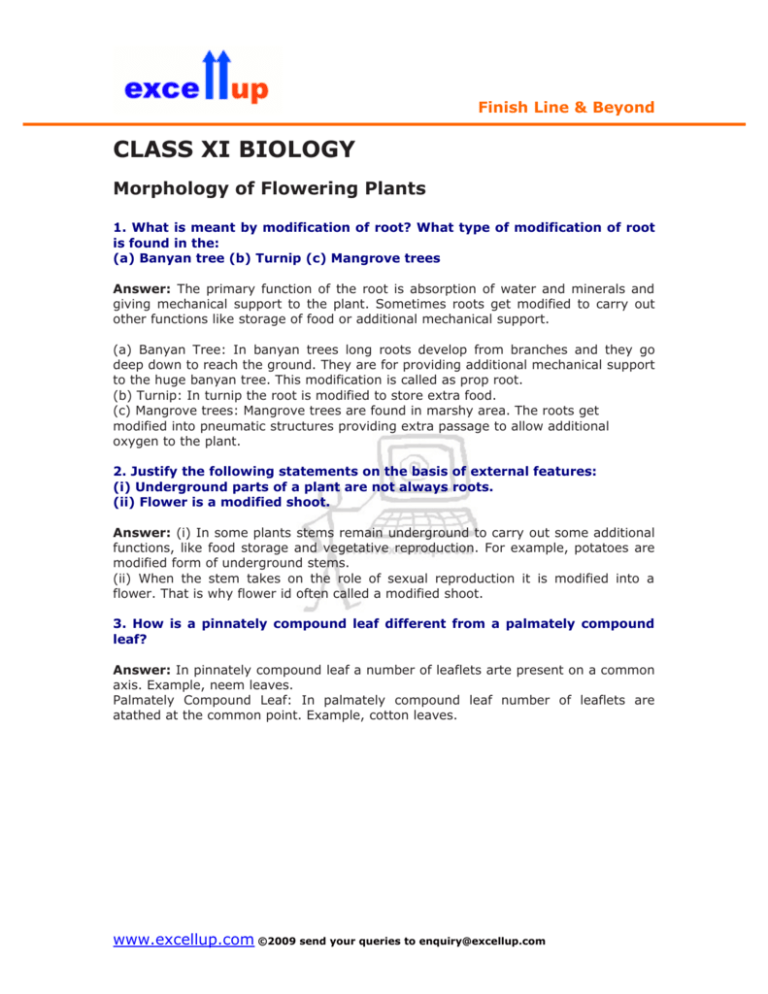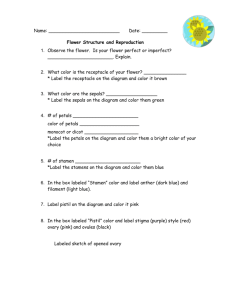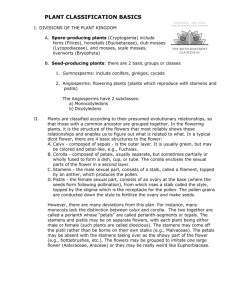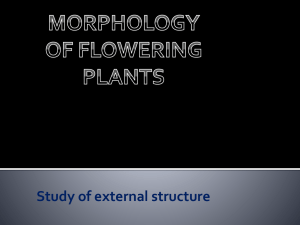Morphology of Flowering Plants
advertisement

Finish Line & Beyond CLASS XI BIOLOGY Morphology of Flowering Plants 1. What is meant by modification of root? What type of modification of root is found in the: (a) Banyan tree (b) Turnip (c) Mangrove trees Answer: The primary function of the root is absorption of water and minerals and giving mechanical support to the plant. Sometimes roots get modified to carry out other functions like storage of food or additional mechanical support. (a) Banyan Tree: In banyan trees long roots develop from branches and they go deep down to reach the ground. They are for providing additional mechanical support to the huge banyan tree. This modification is called as prop root. (b) Turnip: In turnip the root is modified to store extra food. (c) Mangrove trees: Mangrove trees are found in marshy area. The roots get modified into pneumatic structures providing extra passage to allow additional oxygen to the plant. 2. Justify the following statements on the basis of external features: (i) Underground parts of a plant are not always roots. (ii) Flower is a modified shoot. Answer: (i) In some plants stems remain underground to carry out some additional functions, like food storage and vegetative reproduction. For example, potatoes are modified form of underground stems. (ii) When the stem takes on the role of sexual reproduction it is modified into a flower. That is why flower id often called a modified shoot. 3. How is a pinnately compound leaf different from a palmately compound leaf? Answer: In pinnately compound leaf a number of leaflets arte present on a common axis. Example, neem leaves. Palmately Compound Leaf: In palmately compound leaf number of leaflets are atathed at the common point. Example, cotton leaves. www.excellup.com ©2009 send your queries to enquiry@excellup.com Finish Line & Beyond 4. Explain with suitable examples the different types of phyllotaxy. Answer: Phyllotaxy Phyllotaxy is the pattern of arrangement of leaves on the stem or branch. This is usually of three types – alternate, opposite and whorled. Alternate Arrangement of Leaves: In alternate type of phyllotaxy, a single leaf arises at each node in alternate manner, as in china rose, mustard and sun flower plants. Opposite Arrangement of Leaves: In opposite type, a pair of leaves arise at each node and lie opposite to each other as in Calotropis and guava plants. Whorled Arrangement of Leaves: If more than two leaves arise at a node and form a whorl, it is called whorled, as in Alstonia. www.excellup.com ©2009 send your queries to enquiry@excellup.com Finish Line & Beyond 5. Define the following terms: (a) aestivation (b) placentation (c) actinomorphic (d) zygomorphic (e) superior ovary (f) perigynous flower (g) epipetalous stamen Answer: (a) Aestivation: The mode of arrangement of sepals or petals in floral bud with respect to the other members of the same whorl is known as aestivation. The main types of aestivation are valvate, twisted, imbricate and vexillary. Valvate: When sepals or petals in a whorl just touch one another at the margin, without overlapping, as in Calotropis, it is said to be valvate. Twisted: If one margin of the appendage overlaps that of the next one and so on as in china rose, lady’s finger and cotton, it is called twisted. Imbricate: If the margins of sepals or petals overlap one another but not in any particular direction as in Cassia and gulmohur, the aestivation is called imbricate. www.excellup.com ©2009 send your queries to enquiry@excellup.com Finish Line & Beyond Vexillary: In pea and bean flowers, there are five petals, the largest (standard) overlaps the two lateral petals (wings) which in turn overlap the two smallest anterior petals (keel); this type of aestivation is known as vexillary or papilionaceous. (ii) Placentation: The arrangement of ovules within the ovary is known as placentation. The placentation are of different types namely, marginal, axile, parietal, basal, central and free central. Marginal: In marginal placentation the placenta forms a ridge along the ventral suture of the ovary and the ovules are borne on this ridge forming two rows, as in pea. Axile: When the placenta is axial and the ovules are attached to it in a multilocular ovary, the placentaion is said to be axile, as in china rose, tomato and lemon. Parietal: In parietal placentation, the ovules develop on the inner wall of the ovary or on peripheral part. Ovary is one-chambered but it becomes two-chambered due to the formation of the false septum, e.g., mustard and Argemone. When the ovules are borne on central axis and septa are absent, as in Dianthus and Primrose the placentation is called free central. Basal: In basal placentation, the placenta develops at the base of ovary and a single ovule is attached to it, as in sunflower, marigold. (iii) Actinomorphic: When a flower can be divided into two equal radial halves in any radial plane passing through the centre, it is said to be actinomorphic, e.g., mustard, datura, chilli. www.excellup.com ©2009 send your queries to enquiry@excellup.com Finish Line & Beyond (iv) Zygomorphic: When a flower can be divided into two similar halves only in one particular vertical plane, it is zygomorphic, e.g., pea, gulmohur, bean, Cassia. (v) Superior Ovary or Hypogynous Flower: Based on the position of calyx, corolla and androecium in respect of the ovary on thalamus, the flowers are described as hypogynous perigynous and epigynous. In the hypogynous flower the gynoecium occupies the highest position while the other parts are situated below it. The ovary in such flowers is said to be superior, e.g., mustard, china rose and brinjal. (vi) Prigynous Flower: If gynoecium is situated in the centre and other parts of the flower are located on the rim of the thalamus almost at the same level, it is called perigynous. The ovary here is said to be half inferior, e.g., plum, rose, peach. (vii) Epipetalous Stamens: When stamens are attached to the petals, they are epipetalous as in brinjal. 6. Differentiate between (a) Racemose and cymose inflorescence (b) Fibrous root and adventitious root (c) Apocarpous and syncarpous ovary Answer: (a) Racemose Inflorescence: In racemose type of inflorescences the main axis continues to grow, the flowers are borne laterally in an acropetal succession. Acropetal succession means that older flowers are at the base and younger flowers are near the apex. Cymose Inflorescence: In cymose type of inflorescence the main axis terminates in a flower, hence is limited in growth. The flowers are borne in a basipetal order. In basipetal succession older flowers are at the apex and younger flowers are near the base. www.excellup.com ©2009 send your queries to enquiry@excellup.com Finish Line & Beyond (b) Fibrous Root System: In monocotyledonous plants, the primary root is short lived and is replaced by a large number of roots. These roots originate from the base of the stem and constitute the fibrous root system, as seen in the wheat plant. Adventitious Roots: In some plants, like grass, Monstera and the banyan tree, roots arise from parts of the plant other than the radicle and are called adventitious roots. (c) When more than one carpel is present, they may be free (as in lotus and rose) and are called apocarpous. They are termed syncarpous when carpels are fused, as in mustard and tomato. 7. Describe modifications of stem with suitable examples. Answer: Modifications of Stem Food Storage: Stems are modified to perform different functions. Underground stems of potato, ginger, turmeric, zaminkand, Colocasia are modified to store food in them. They also act as organs of perenation to tide over conditions unfavourable for growth. Tendrils: Stem tendrils which develop from axillary buds, are slender and spirally coiled and help plants to climb such as in gourds (cucumber, pumpkins, watermelon) and grapevines. Thorns: Axillary buds of stems may also get modified into woody, straight and pointed thorns. Thorns are found in many plants such as Citrus, Bougainvillea. They protect plants from browsing animals. www.excellup.com ©2009 send your queries to enquiry@excellup.com Finish Line & Beyond Some plants of arid regions modify their stems into flattened (Opuntia), or fleshy cylindrical (Euphorbia) structures. They contain chlorophyll and carry out photosynthesis. Vegetative Reproduction: Underground stems of some plants such as grass and strawberry, etc., spread to new niches and when older parts die new plants are formed. In plants like mint and jasmine a slender lateral branch arises from the base of the main axis and after growing aerially for some time arch downwards to touch the ground. A lateral branch with short internodes and each node bearing a rosette of leaves and a tuft of roots is found in aquatic plants like Pistia and Eichhornia. In banana, pineapple and Chrysanthemum, the lateral branches originate from the basal and underground portion of the main stem, grow horizontally beneath the soil and then come out obliquely upward giving rise to leafy shoots. 8. Take one flower each of the families Fabaceae and Solanaceae and write its semi-technical description. Also draw their floral diagram after studying them. Answer: Fabaceae This family was earlier called Papilonoideae, a subfamily of family Leguminosae. It is distributed all over the world. Vegetative Characters Trees, shrubs, herbs; root with root nodules Stem: erect or climber Leaves: alternate, pinnately compound or simple; leaf base, pulvinate; stipulate; venation reticulate. Floral characters Inflorescence: racemose Flower: bisexual, zygomorphic Calyx: sepals five, gamosepalous; imbricate aestivation www.excellup.com ©2009 send your queries to enquiry@excellup.com Finish Line & Beyond Corolla: petals five, polypetalous, papilionaceous, consisting of a posterior standard, two lateral wings, two anterior ones forming a keel (enclosing stamens and pistil), vexillary aestivation Androecium: ten, diadelphous, anther dithecous Gynoecium: ovary superior, mono carpellary, unilocular with many ovules, style single Fruit: legume; seed: one to many, non-endospermic Floral Formula: ⊕ K(5) C1+2+(2) A(9)+1 G1 Economic importance Many plants belonging to the family are sources of pulses (gram, arhar, sem, moong, soyabean; edible oil (soyabean, groundnut); dye (indigofera); fibres (sunhemp); fodder (Sesbania, Trifolium), ornamentals (lupin, sweet pea); medicine (muliathi). Solanaceae It is a large family, commonly called as the ‘potato family’. It is widely distributed in tropics, subtropics and even temperate zones. Vegetative Characters Plants mostly, herbs, shrubs and small trees Stem: herbaceous rarely woody, aerial; erect, cylindrical, branched, solid or hollow, hairy or glabrous, underground stem in potato (Solanum tuberosum) Leaves: alternate, simple, rarely pinnately compound, exstipulate; venation reticulate www.excellup.com ©2009 send your queries to enquiry@excellup.com Finish Line & Beyond Floral Characters Inflorescence : Solitary, axillary or cymose as in Solanum Flower: bisexual, actinomorphic Calyx: sepals five, united, persistent, valvate aestivation Corolla: petals five, united; valvate aestivation Androecium: stamens five, epipetalous Gynoecium: bicarpellary, syncarpous; ovary superior, bilocular, placenta swollen with many ovules Fruits: berry or capsule Seeds: many, endospermous Floral Formula: Economic Importance Many plants belonging to this family are source of food (tomato, brinjal, potato), spice (chilli); medicine (belladonna, ashwagandha); fumigatory (tobacco); ornamentals (petunia). 9. Describe the various types of placentations found in flowering plants. Answer: Placentation: The arrangement of ovules within the ovary is known as placentation. The placentation are of different types namely, marginal, axile, parietal, basal, central and free central. Marginal: In marginal placentation the placenta forms a ridge along the ventral suture of the ovary and the ovules are borne on this ridge forming two rows, as in pea. Axile: When the placenta is axial and the ovules are attached to it in a multilocular ovary, the placentaion is said to be axile, as in china rose, tomato and lemon. www.excellup.com ©2009 send your queries to enquiry@excellup.com Finish Line & Beyond Parietal: In parietal placentation, the ovules develop on the inner wall of the ovary or on peripheral part. Ovary is one-chambered but it becomes two-chambered due to the formation of the false septum, e.g., mustard and Argemone. When the ovules are borne on central axis and septa are absent, as in Dianthus and Primrose the placentation is called free central. Basal: In basal placentation, the placenta develops at the base of ovary and a single ovule is attached to it, as in sunflower, marigold. 10. What is a flower? Describe the parts of a typical angiosperm flower. Answer: THE FLOWER The flower is the reproductive unit in the angiosperms. It is meant for sexual reproduction. A typical flower has four different kinds of whorls arranged successively on the swollen end of the stalk or pedicel, called thalamus or receptacle. These are calyx, corolla, androecium and gynoecium. Calyx and corolla are accessory organs, while androecium and gynoecium are reproductive organs. In some flowers like lily, the calyx and corolla are not distinct and are termed as perianth. Parts of a Flower Each flower normally has four floral whorls, viz., calyx, corolla, androecium and gynoecium. Calyx: The calyx is the outermost whorl of the flower and the members are called sepals. Generally, sepals are green, leaf like and protect the flower in the bud stage. The calyx may be gamosepalous (sepals united) or polysepalous (sepals free). www.excellup.com ©2009 send your queries to enquiry@excellup.com Finish Line & Beyond Corolla: Corolla is composed of petals. Petals are usually brightly coloured to attract insects for pollination. Like calyx, corolla may be also free (gamopetalous) or united (polypetalous). The shape and colour of corolla vary greatly in plants. Corolla may be tubular, bell-shaped, funnel-shaped or wheel-shaped. Androecium Androecium is composed of stamens. Each stamen which represents the male reproductive organ consists of a stalk or a filament and an anther. Each anther is usually bilobed and each lobe has two chambers, the pollen-sacs. The pollen grains are produced in pollen-sacs. A sterile stamen is called staminode. Stamens of flower may be united with other members such as petals or among themselves. When stamens are attached to the petals, they are epipetalous as in brinjal, or epiphyllous when attached to the perianth as in the flowers of lily. The stamens in a flower may either remain free (polyandrous) or may be united in varying degrees. The stamens may be united into one bunch or one bundle (monoadelphous) as in china rose, or two bundles (diadelphous) as in pea, or into more than two bundles (polyadelphous) as in citrus. There may be a variation in the length of filaments within a flower, as in Salvia and mustard. Gynoecium Gynoecium is the female reproductive part of the flower and is made up of one or more carpels. A carpel consists of three parts namely stigma, style and ovary. Ovary is the enlarged basal part, on which lies the elongated tube, the style. The style connects the ovary to the stigma. The stigma is usually at the tip of the style and is the receptive surface for pollen grains. Each ovary bears one or more ovules attached to a flattened, cushion-like placenta. When more than one carpel is present, they may be free (as in lotus and rose) and are called apocarpous. They are termed syncarpous when carpels are fused, as in mustard and tomato. After fertilisation, the ovules develop into seeds and the ovary matures into a fruit. 11. How do the various leaf modifications help plants? Answer: Modifications of Leaves Leaves are often modified to perform functions other than photosynthesis. Tendrils: They are converted into tendrils for climbing as in peas or into spines for defence as in cacti. Bulb: The fleshy leaves of onion and garlic store food. In some plants such as Australian acacia, the leaves are small and short-lived. The petioles in these plants expand, become green and synthesise food. Leaves of certain insectivorous plants such as pitcher plant, venus-fly trap are also modified leaves. www.excellup.com ©2009 send your queries to enquiry@excellup.com Finish Line & Beyond 12. Define the term inflorescence. Explain the basis for the different types inflorescence in flowering plants. Answer: THE INFLORESCENCE A flower is a modified shoot wherein the shoot apical meristem changes to floral meristem. Internodes do not elongate and the axis gets condensed. The apex produces different kinds of floral appendages laterally at successive nodes instead of leaves. When a shoot tip transforms into a flower, it is always solitary. The arrangement of flowers on the floral axis is termed as inflorescence. Depending on whether the apex gets converted into a flower or continues to grow, two major types of inflorescences are defined – racemose and cymose. Racemose Inflorescence: In racemose type of inflorescences the main axis continues to grow, the flowers are borne laterally in an acropetal succession. Acropetal succession means that older flowers are at the base and younger flowers are near the apex. Cymose Inflorescence: In cymose type of inflorescence the main axis terminates in a flower, hence is limited in growth. The flowers are borne in a basipetal order. In basipetal succession older flowers are at the apex and younger flowers are near the base. www.excellup.com ©2009 send your queries to enquiry@excellup.com Finish Line & Beyond 13. Write the floral formula of a actinomorphic, bisexual, hypogynous flower with five united sepals, five free petals, five free stamens and two united carples with superior ovary and axile placentation. Answer: Solanaceae www.excellup.com ©2009 send your queries to enquiry@excellup.com








